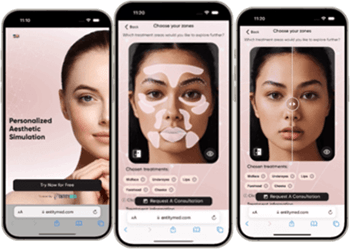 Click Here To See Your Personalized Aesthetic Simulated Results
Click Here To See Your Personalized Aesthetic Simulated Results
 Click Here To See Your Personalized Aesthetic Simulated Results
Click Here To See Your Personalized Aesthetic Simulated Results
Top Doctor

Top Doctor

Top Doctor

Verified

Contributor

Losing weight—especially through a medical weight loss program—is often framed as a path to better health, confidence, and longevity. But what happens when the weight is gone, and you’re left with loose, sagging skin instead of healthy skin?
For many people, significant weight loss comes with an unexpected challenge: skin that no longer fits the body it once covered. The human skin is highly adaptive, but it doesn’t always bounce back after weight loss, especially if the process happens too quickly or if elasticity is already compromised.
The good news? Loose skin isn’t an inevitable outcome. The key is understanding why it happens, how to prevent it, and what treatments can help if it becomes a concern. Whether you’re just beginning your weight loss journey or dealing with the aftermath of massive weight loss, this guide will help you navigate the science of skin elasticity, treatment options, and realistic expectations.
Your skin is more than just an outer layer—it’s a living, breathing organ composed of collagen, elastin, and hydration-dependent connective tissues. These components expand and contract based on the body’s needs, affecting the skin's elasticity. However, when weight is gained and carried for an extended period, the skin stretches to accommodate the extra body fat.
Once the weight is lost, the skin may not fully contract—especially if collagen production has slowed down due to aging, dehydration, or excessive sun exposure over time. The result? Sagging skin that feels deflated, particularly in areas like the abdomen, arms, thighs, and face.
Several factors influence whether the skin will tighten naturally:
For many, weight loss is supposed to be an empowering transformation—but dealing with sagging skin can dampen the excitement. Some individuals feel frustrated when their hard-earned progress doesn’t reflect the toned, sculpted look they imagined.
Even with a healthier weight, loose skin can create self-consciousness about appearance. Some people may avoid certain clothing styles or feel anxious in social situations or intimate settings.
Many experience a mix of emotions, ranging from pride over weight loss to disappointment over excess skin. Studies show that some individuals develop body dysmorphia, focusing on perceived flaws rather than celebrating their health improvements.
Coping Strategies:
Collagen and elastin are the building blocks of skin strength and flexibility. When weight loss is rapid, the body doesn’t always produce enough of these fibers to support the skin’s new shape.
If you’re in the early stages of weight loss, the best way to avoid loose skin is to lose weight gradually. Experts recommend 1-2 pounds per week, allowing the skin time to adjust to the body’s changing shape. Crash diets and extreme calorie deficits can accelerate weight loss but often lead to more sagging skin in the long run.
When people lose weight quickly, they often lose muscle mass along with fat—leaving behind a loose, soft appearance. Incorporating strength training at least 3 times per week helps preserve and build muscle, which fills out the skin and provides a firmer, more toned look. Exercises like resistance training, weightlifting, and bodyweight exercises can make a huge difference in body composition post-weight loss.
Skin hydration plays a massive role in how well the skin rebounds after weight loss, contributing to healthy skin. Staying well-hydrated helps maintain skin moisture and prevents it from becoming thin and crepey. But hydration isn’t just about water—nutrients like Vitamin C, fatty acids, and collagen-boosting foods help strengthen skin structure and promote elasticity.
Key Nutrients for Healthy, Firm Skin:
Using topical treatments can help support skin health, but they won’t perform miracles. However, retinoids, peptides, and firming creams can boost collagen production, while daily SPF application prevents sun damage, which breaks down existing collagen and accelerates skin aging.
For those dealing with mild to moderate sagging, non-invasive treatments can improve skin elasticity and firmness. These treatments work by stimulating collagen regeneration and increasing skin tightness over time.
Radiofrequency (RF) Therapy
Ultrasound-Based Skin Tightening (Ultherapy)
Laser Resurfacing & Fractional Laser Therapy
Microneedling with RF
For individuals with severe excess skin, body contouring surgeries may be the best option. Surgery is typically recommended if loose skin is causing irritation, discomfort, or hygiene issues, and to remove excess skin.
Skin tightening procedures vary in effectiveness and affordability.
| Treatment | Cost Estimate | Best For |
| Radiofrequency Therapy | $500-$3,000 per session | Mild sagging |
| Laser Resurfacing | $1,500-$5,000 per session | Fine lines, minor loose skin |
| Ultrasound Skin Tightening | $2,000-$4,500 | Moderate sagging |
| Tummy Tuck (Abdominoplasty) | $8,000-$15,000 | Severe excess skin |
| Arm Lift (Brachioplasty) | $5,000-$9,000 | Loose skin on upper arms |
Loose skin after weight loss isn’t just a cosmetic issue—it can impact body image, confidence, and overall well-being. The key to preventing sagging skin is gradual weight loss, resistance training, and skin-supportive nutrition.
For those dealing with excess skin, non-invasive treatments or body contouring surgery may offer a solution. No matter where you are in your weight loss journey, remember that your body’s transformation is a testament to your hard work.
Philadelphia plastic surgeon Dr. Ran Stark brings decades of experience and training to each consultation. When you meet with Dr. Stark, he takes the time to give you information and options, so you can have confidence in your decision to move forward with the best procedure for you. Confidence. Personalized care. Impeccable results. That’s the Stark Difference. Discover that difference yourself by scheduling a consultation with Dr. Stark today.
135 South Bryn Mawr Ave, Suite 220, Bryn Mawr, PA 19010